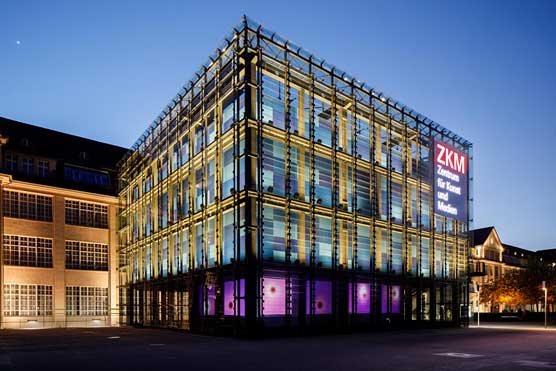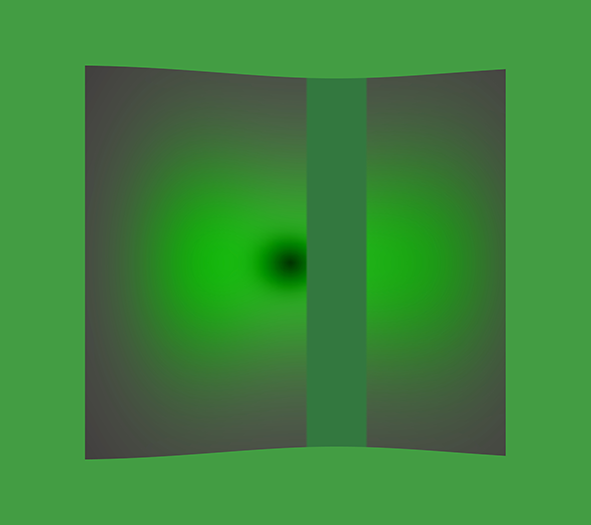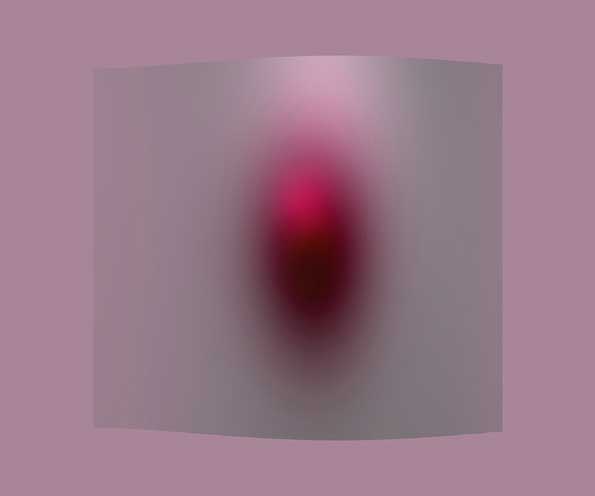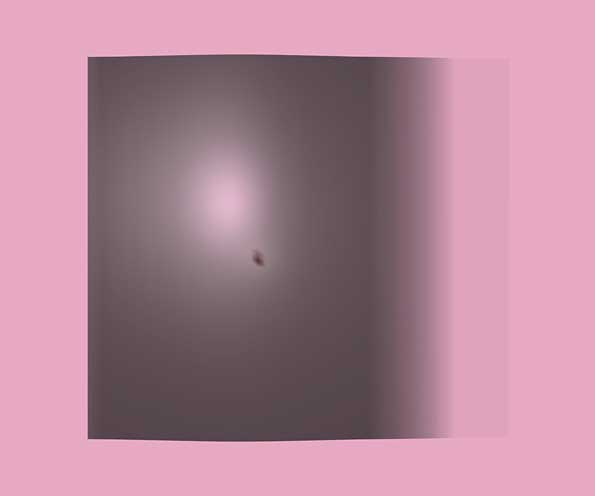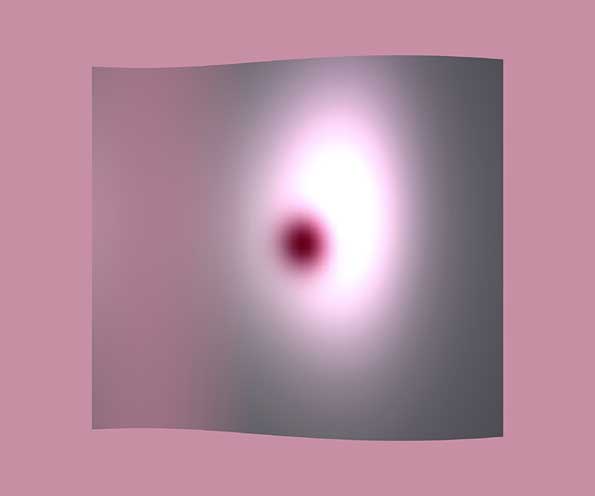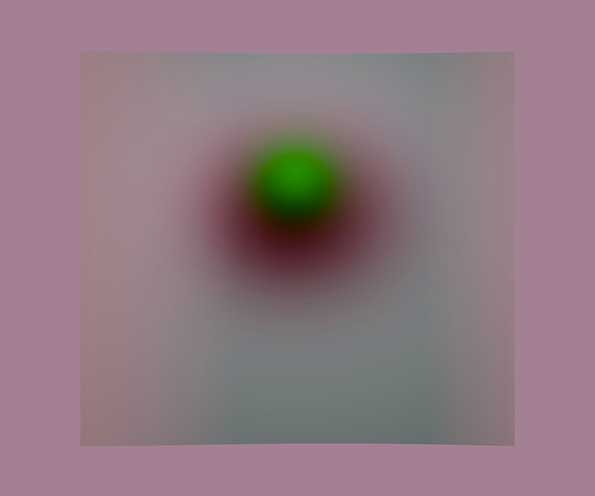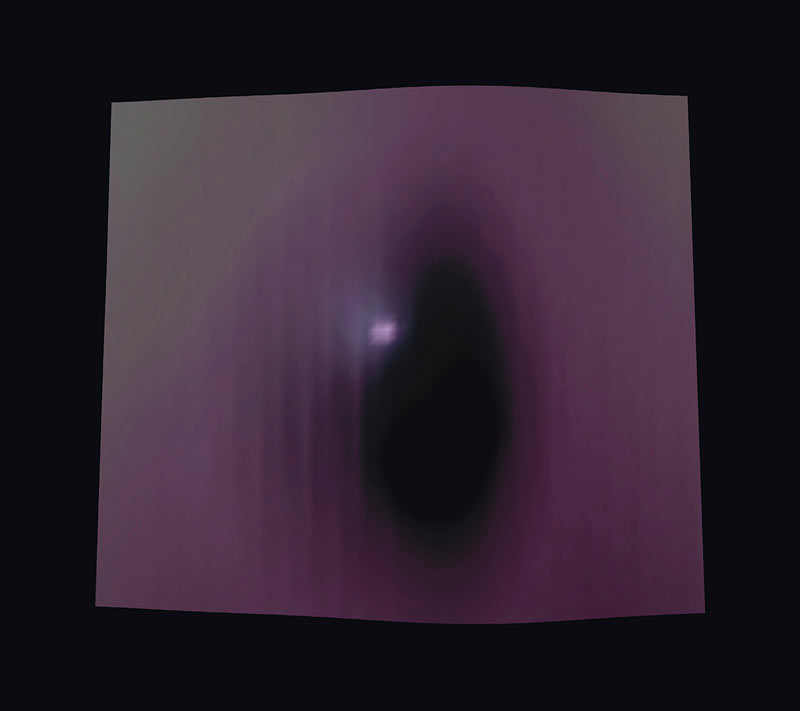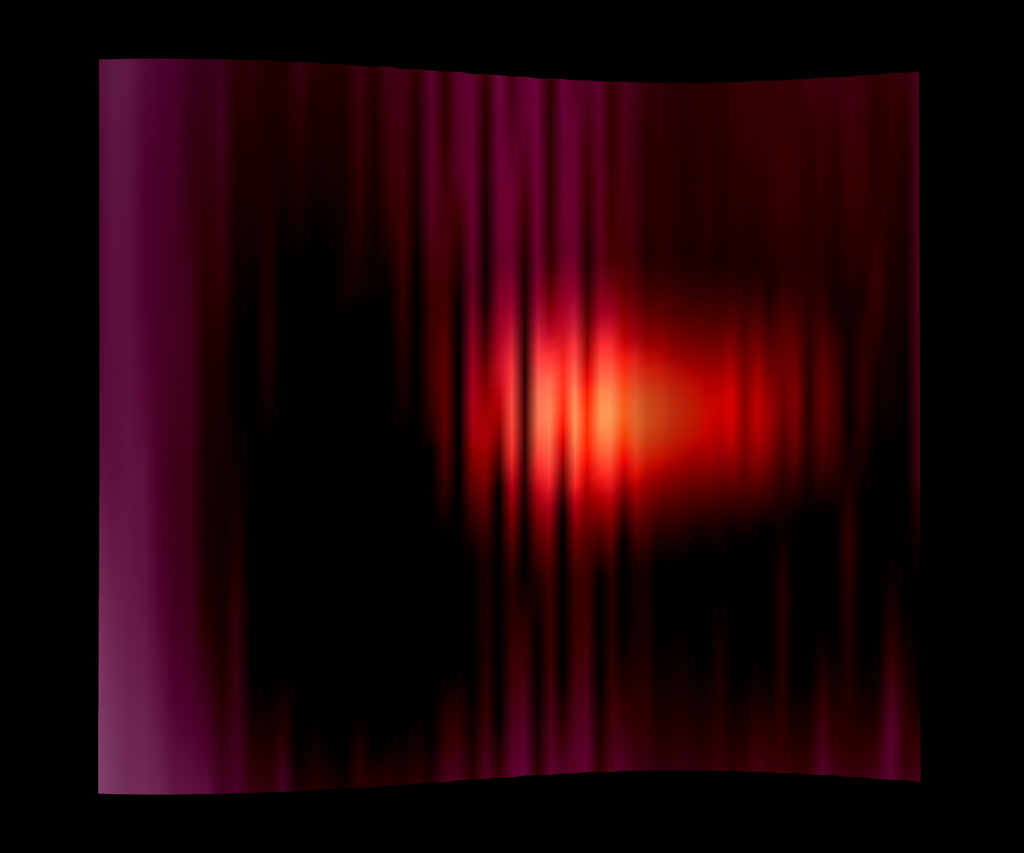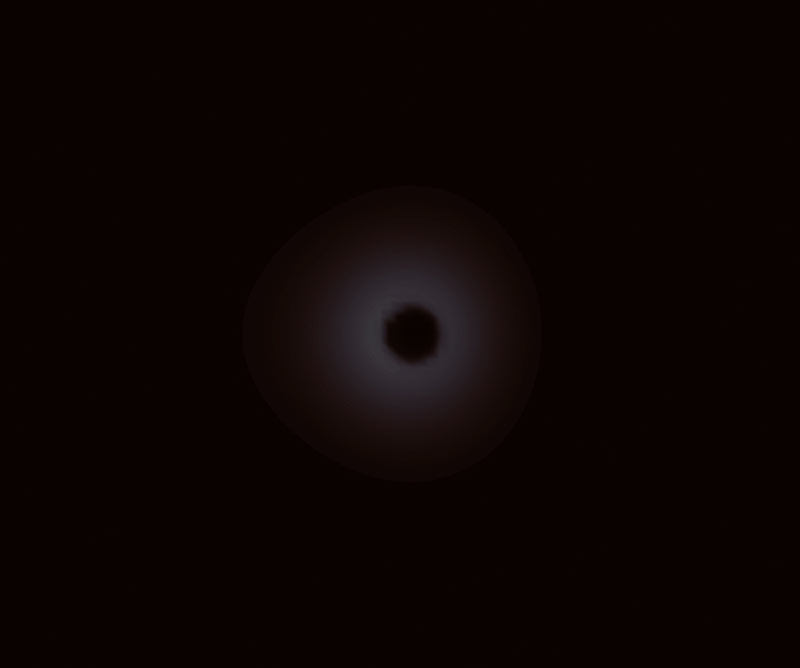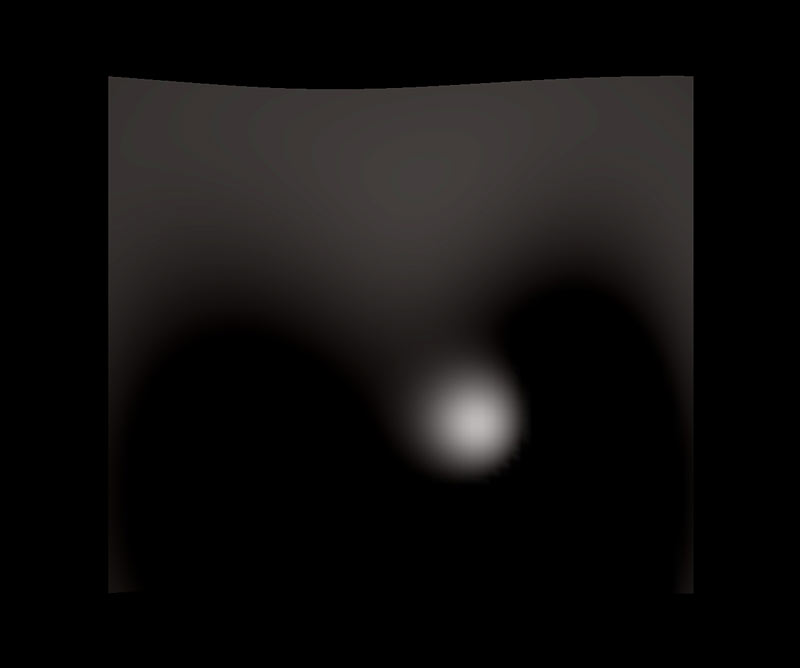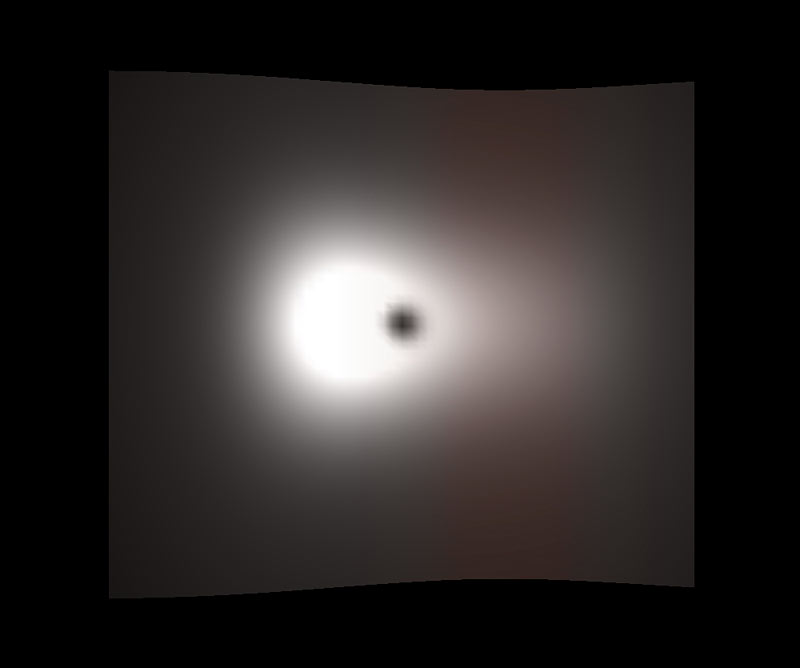Anne-Sarah Le Meur
Since 1990, Anne-Sarah Le Meur has been using computers and computer language to create her images. Her mixing and exploration of numbers, iterations and loops and her modulation of shapes, colours and rhythms would most certainly not be possible without them. While claiming a pictorial heritage (Turrell, Rothko, Monet... Guston), Anne-Sarah Le Meur seeks the limits of computer graphics: What would be the most elementary 3D technically possible? Can the 3D image be flat rather than ostensibly three-dimensional? Can the luminous phenomena of virtual space differ from those of our concrete space? How does one nuance tones in precisely controlled, yet seemingly unfocused, field of colour... Does the artist’s body still influence creation when it takes root in computers? Thus emerges a dreamlike world, abstract of course, but alive, teeming, strangely organic, almost sensual.
Her images take various forms, fixed or animated, recorded or generative, projected in performance (sound or silent), or exhibited in photographic prints. She has also created an interactive piece for cylindrical screens, based on peripheral vision, where slow gaze activates the image (ZKM, 2011). Vermille, a river work written over several years, broadcast on a single screen or in polyptych, plays on the series of colourful variations.
Her latest work, DixVerts, a polyptych with 4 projections, exhibited at Vidéoformes in 2023, presents a slow abstract ballet where movements, hues, and spatial sensations interact and captivate the eye.
After studying 3D artistic image at the University of Paris 8, Anne-Sarah Le Meur teaches digital practices at the University Bauhaus-Weimar and then at the University of Paris 1, Ecole des Arts de la Sorbonne. Her research activity is divided between teaching, creating and writing articles, and participating in conferences and festivals.
Exhibitions
Past- + Anne-Sarah Le Meur - January '12
- + Anne-Sarah Le Meur - July '14
- + Slick Art Fair - October '15
- + Anne-Sarah Le Meur Immatière - March '16
- + Opening Galerie Charlot Tel Aviv: The Artside of Algorithms - August '17
- + Generative Landscape - September '18
- + Anne-Sarah Le Meur Rose Apothéose - December '18
- + Galerie Charlot 10-Year Anniversary Exhibition - September '20
- + Origin'Elle - May '21
- + Digital Art Waves - September '22
- + My1st collection - December '24
Fairs
- + 06/16/2025 | The Digital Art Mile : ARTMETA - Basel 2025
News
- + 10/16/2025 | Antoine Schmitt, Anne-Sarah Le Meur, and Eduardo Kac Featured in "Cinétique Quantique"
- + 10/10/2025 | Anne-Sarah Le Meur - "Rive droite / Rive gauche"
- + 07/17/2025 | Anne-Sarah Le Meur - Group show "Traverse" at the Orangerie of the Senate, Jardin du Luxembourg, Paris
- + 04/13/2025 | Anne-Sarah Le Meur - exhibition "Sans Transition" at Jing Art Center in Nanjing, China
- + 04/08/2025 | Anne-Sarah Le Meur - theory-practice workshop: "Digital art: structure, code, disruption"
- + 05/29/2024 | Chambre d'ondes. Anne-Sarah Le Meur, Vitrine des essais, Lycée Montaigne, Bordeaux
- + 11/17/2023 | Festival Artifice Numérique #06, Energies, Le Hublot
- + 10/07/2023 | Guérison Globale/Global Healing', Miami New Media Festival, Miami, USA
- + 03/30/2023 | Exhibition Source Code with works by Anne-Sarah Le Meur, Manfred Mohr, Olivier Ratsi, Antoine Schmitt & Eric Vernhes.
- + 03/16/2023 | Festival VIDEOFORMES with works by Anne-Sarah Le Meur
- + 09/01/2022 | Launch of the NFT platform of the Galerie Charlot -
Opening on September 1st
- + 02/23/2022 | Anne-Sarah Le Meur @ Centre Wallonie-Bruxelles Paris
- + 12/03/2021 | 'Lumière, Espace, Temps' @ Le Grenier à sel, Avignon has been prolonged until January 29!
- + 10/09/2021 | Anne-Sarah Le Meur & Antoine Schmitt @ Fondation EDIS Avignon
- + 09/09/2021 | Sabrina Ratté and Anne-Sarah Le Meur @ Scopitone Festival
- + 07/01/2021 | Anne-Sarah Le Meur, Antoine Schmitt, Sabrina Ratté & Manfred Mohr @ Le Miroir de Poitiers
- + 09/18/2020 | Anne-Sarah Le Meur @ CEAAC, Strasbourg
- + 09/09/2020 | Galerie Charlot @ Ars Electronica - In Kepler Gardens
- + 03/12/2020 | Anne-Sarah Le Meur @ La Ruche, Paris
- + 03/11/2020 | Anne-Sarah Le Meur @ ZKM, Karlsruhe
- + 01/25/2020 | Talk with Jean-Rodolphe Loth - Anne-Sarah Le Meur @ Ancienne Église, Maison-Laffitte
- + 01/18/2020 | Exhibition Nombres Ecarlates - Anne-Sarah Le Meur @ Ancienne Église, Maison-Laffitte
- + 03/15/2019 | Anne-Sarah Le Meur @ Plateforme, Paris
- + 04/27/2018 | Anne-Sarah Le Meur at MUNA, Uberlândia, Brazil
- + 02/22/2018 | "La belle synthèse plasticienne" - Video projection, Selection and presentation by Anne-Sarah Le Meur at The Cube, Issy-les-Moulineaux
- + 01/26/2018 | Anne-Sarah Le Meur, Au creux de l'obscur, solo show, Le Cube, Issy-les-Moulineaux
- + 11/13/2017 | Anne-Sarah Le Meur at seminar "Magie Numérique", Ecole Nationale Supérieure Louis Lumière, Saint-Denis
- + 10/07/2017 | Anne-Sarah Le Meur at Nuit Blanche Off, Paris
- + 07/22/2017 | Anne-Sarah Le Meur at La Générale, Paris
- + 10/28/2016 | Anne-Sarah Le Meur @ L'acteur à travers le prisme du numérique
- + 10/20/2015 | Galerie Charlot @ Slick Art Fair 2015
- + 06/25/2015 | Anne-Sarah Le Meur @ Galerie RuArts, Moscou
- + 06/09/2015 | Anne-Sarah Le Meur @ Ralentir Peintures
- + 06/02/2015 | Anne-Sarah Le Meur @ Image 3D amoureuse, Le Cube
- + 04/16/2015 | Anne-Sarah Le Meur @ MUDO, Beauvais
- + 10/21/2014 | Anne-Sarah Le Meur @ Variation Show Off Paris from the 21st to the 26th of October
- + 10/20/2014 | Galerie Charlot @ Variation - Paris Media Art Fair, 21-26 October 2014
- + 05/08/2014 | Anne-Sarah Le Meur @ HFG Karlsruhe
- + 05/15/2012 | Anne-Sarah Le Meur @ Seuils-Lumière, Centre le Chaplin
- + 03/02/2012 | Anne-Sarah Le Meur @ Workshop IRCAM / LIMSI-CNRS
Editions
- + Anne-Sarah Le Meur - Immatière
Booklet 32 pages, color, ISBN : 978-2-9541000-1-2
2016 - Galerie Charlot Èdition - + Anne-Sarah Le Meur - Outre Ronde
Booklet 24 pages, color, ISBN 978-2-9541000-3-6
2016 - Galerie Charlot Èdition - + Anne-Sarah Le Meur - Rose Apothéose
24 pages
2018 - Galerie Charlot Èdition - + Origin'elle
Booklet , 50 pages
2021 - Galerie Charlot Èdition - + Anne-Sarah Le Meur. DixVerts
Editions Galerie Charlot, Paris, 2024, Livret 24 pages
2024 - Galerie Charlot Èdition
Press
- + 09/13/2022 | Anne-Sarah Le Meur. Peinture Programmée
by Jean-Jacques Gay
_ anne-sarah-le-meur-p...pdf ( PDF, 338.33 KB ) - + 10/01/2021 | “L’ATELIER DES MÉMOIRES VIVES ET IMAGINAIRES. ART, INFORMATIQUE ET CYBERNÉTIQUE”
by Etienne Hatt, ArtPress
> https://www.artpress.com/2021/10/01/late... - + 09/05/2021 | Scopitone à Nantes : « l’Hyper nature » au tempo de l’électro
by Véronique Godé, Arts Hebdo Médias
> https://www.artshebdomedias.com/article/... - + 07/09/2021 | Les relations entre l’art et l’informatique à la chapelle Saint-Louis
_ latelier-des-memoire...pdf ( PDF, 836.08 KB ) - + 07/09/2021 | Art et informatique à Poitiers
_ latelier-des-memoire...pdf ( PDF, 134.27 KB ) - + 07/01/2021 | Regards sur les relations entre art et informatique
_ latelier-des-memoire...pdf ( PDF, 396.64 KB ) - + 07/01/2021 | Le Miroir entre art et cyberculture
_ le-miroir-entre-art-...pdf ( PDF, 167.37 KB ) - + 06/29/2021 | L’art digital sensible au féminin
by Manon Schaefle, Arts Hebdo Médias
> https://www.artshebdomedias.com/article/...
_ lart-digital-sensibl...jpg ( JPG, 205.62 KB ) - + 09/29/2020 | Galerie d'art et Covid : entre galère inédite et rebond inespéré
by Anne Lamotte, France Culture
> https://www.franceculture.fr/emissions/l... - + 05/15/2020 | Anne-Sarah Le Meur déploie Omni-Vermille
by Philippe-Etienne Masséna, Arts Hebdo Médias
> https://www.artshebdomedias.com/article/... - + 01/09/2019 | Anne-Sarah Le Meur, « Rose Apothéose »: Trouble de la perception
by Pauline Lisowski, Inferno Magazine
> https://inferno-magazine.com/2019/01/09/... - + 01/09/2019 | De la fascination à la contemplation du rose
by Marie-Laure Desjardins, Arts Hebdo Médias
> artshebdomedias.com/article/de-la... - + 12/14/2018 | Rose Apothéose
Wall Street International
> https://wsimag.com/art/47117-rose-apothe...
_ rose-apotheose-galer...pdf ( PDF, 272.72 KB ) - + 06/01/2018 | Les lumières obscures d'Anne-Sarah Le Meur
by Anne Brandebourg, Vallée de la culture 17
_ les-lumieres-obscure...pdf ( PDF, 1.34 MB ) - + 03/09/2018 | Une plongée séduisante dans l'abstraction en 3D
by Alix Saint-Martin, HDS Mag
> aslemeur.free.fr/projets/txt/Cube... - + 05/27/2017 | The Artside of Algorithms Exhibition Opening
Secret Tel Aviv
> https://www.secrettelaviv.com/tickets/th...
_ the-artside-of-algor...pdf ( PDF, 369.03 KB ) - + 05/26/2017 | 'The Artside of Algorithms' at Gallery Charlot, Tel Aviv
Blouin ArtInfo
> enme.blouinartinfo.com/news/story...
_ the-artside-of-algor...pdf ( PDF, 245.28 KB ) - + 01/10/2017 | L'art digital
by Sylvie Loiseau, Dailyshopedito
> www.dailyshopedito.com/exposition...
_ lart-digital-galerie...pdf ( PDF, 1.8 MB ) - + 03/14/2016 | Anne-Sarah Le Meur à Paris. Et l’obscurité devient refuge
by Samantha Deman, ArtsHebdoMedias
> www.artshebdomedias.com/article/1...
_ anne-sarah-le-meur-a...pdf ( PDF, 311.03 KB ) - + 10/23/2015 | Semaine de l’art contemporain à Paris
Un autre monde
by Charlotte Waligòra, ArtsHebdo Médias
> www.artshebdomedias.com/article/2...
_ semaine-de-lart-cont...pdf ( PDF, 2.15 MB ) - + 10/21/2015 | Slick 2015 : l'anti Fiac qui résiste bien
by Thierry Hay, France tv info
> culturebox.francetvinfo.fr/le-blo...
_ slick-2015--lanti-fi...pdf ( PDF, 664.6 KB ) - + 06/20/2014 | Rouge funambule
by Marie-Laure Desjardins, Arts Hebdo Medias
> www.artshebdomedias.com/article/2...
_ rouge-funambule-gale...pdf ( PDF, 111.23 KB ) - + 06/13/2014 | Anne-Sarah Le Meur
The Engine Institute Inc.
> theengineinstitute.org/anne-sarah...
_ anne-sarah-le-meur-g...pdf ( PDF, 65.99 KB ) - + 01/01/2014 | Temporalité abstraite
by Natalia Smolianskaïa, Revue Rue Descartes
> www.ruedescartes.org/articles/201...
_ temporalite-abstrait...pdf ( PDF, 147.24 KB ) - + 02/01/2012 | Anne-Sarah Le Meur à Paris. L’intersection sensible
by Marie-Laure Desjardins, ArtsHebdoMédias
> www.artshebdomedias.com/article/0...
_ anne-sarah-le-meur-a...pdf ( PDF, 551.05 KB ) - + 01/28/2012 | Le Meur à la Galerie Charlot : moment de grâce
by Pierre Berger, Diccan.com
> diccan.com/Autres_auteurs/Le_Meur...
_ le-meur-a-la-galerie...pdf ( PDF, 65.67 KB ) - + 01/27/2012 | Galerie Charlot
by Rachel Meresse, smaaks.com
> www.smaaks.com/galerie-charlot.ht...
_ galerie-charlot-gale...pdf ( PDF, 327.49 KB )
My1st
Press Release & Details
Rose Apothéose
byGenerative work
Computer, specific program, screen or projector
5 copies + 2 ap
Infinite
2018
Vermille - version 3
byGenerative work
Computer, specific program, screen or projector
5 copies + 2 ap
2018


